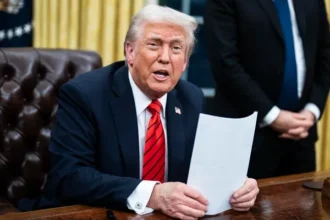The United States is moving forward with its plan to introduce reciprocal tariffs, although the implementation has been slightly delayed. President Donald Trump announced that Secretary of Commerce Lutnick is currently working on the details of the tariff strategy. The goal is to ensure that other countries impose similar duties on American goods as the U.S. does on imports.
A comprehensive study on reciprocal tariffs is in progress and is expected to be completed by April 1. If President Trump approves the plan, these new tariffs could be implemented as early as April 2. The focus of this policy is to create a fair trading environment and to prevent countries from charging higher tariffs on U.S. goods while benefiting from lower tariffs on their own exports to America.
Secretary Lutnick emphasized that Canada and Mexico are critical trade routes for goods coming from India and China. Because of this, the U.S. will closely examine their role in global trade to determine whether stricter trade measures are necessary.
President Trump made it clear that no exemptions or waivers will be granted under the reciprocal tariff policy. This means that every country trading with the U.S. will be subject to the same rules, with no special treatment for specific nations or industries.
In addition to reciprocal tariffs, Trump hinted that new tariffs on automobiles, steel, aluminum, and pharmaceuticals will be introduced soon. However, he did not specify when these tariffs would take effect. Importantly, auto tariffs will have no exemptions, which could have a significant impact on car manufacturers and international automobile trade.
Trump also issued a strong warning to the BRICS nations (Brazil, Russia, India, China, and South Africa). He stated that if these countries attempt to undermine the U.S. dollar, they could face a 100% tariff on their exports to the U.S.. This would be a severe penalty aimed at discouraging actions that weaken the dollar’s dominance in global trade.
Regarding China, Trump acknowledged that a meeting with Chinese officials is on the horizon, but he did not provide any specific date or details on what will be discussed. This adds uncertainty to U.S.-China trade relations.
Finally, President Trump suggested that Value Added Tax (VAT) could be treated similarly to tariffs. If this approach is adopted, it could significantly impact trade policies, especially with the European Union (EU), where VAT systems are widely used.
Overall, these developments indicate that the U.S. is taking a tougher stance on trade. The government is pushing for fairer tariffs, stronger enforcement of trade laws, and new measures to protect American businesses. The coming months will be crucial in shaping the future of global trade under these new policies.







